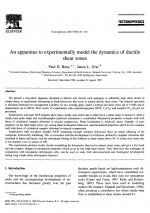Добрый день, Коллеги. Важное сообщение, просьба принять участие. Музей Ферсмана ищет помощь для реставрационных работ в помещении. Подробности по ссылке
An apparatus to experimentally model the dynamics of ductile shear zones
We present a ring-shear apparatus designed to deform soft, ductile rock analogues to arbitrarily high shear strains in simple shear, in experiments attempting to model processes that occur in natural ductile shear zones. The sintered specimen is deformed between two unsupported cylinders by two rotating grips, under a normal and shear stress up to 5 MPa and at temperatures up to 600 K. First results of experiments with octachloropropane (OCP, C3C18) and camphor (C10Hl6O) are presented.
Experiments with pure OCP samples show that a steady-state strain rate is achieved at a shear strain of around 4, when a steady-state grain shape and crystallographic preferred orientation is established. Mechanical properties compare well with those of cylindrical samples deformed in triaxial compression. Shear localisation is relatively minor. Samples of pure camphor, on the other hand, show very strong shear localisation behaviour, and mechanical properties which do not compare well with those of cylindrical samples deformed in triaxial compression.
Experiments with two-phase samples (OCP containing stronger camphor inclusions) show an initial softening of the composite, followed by hardening. This is associated with the development of a foliation, defined by camphor inclusions that stretched to lenses and layers, and the subsequent folding of this foliation at shear strains above 50. A steady-state strain rate is not reached, even at strains of 100.
The experiments produce results closely resembling the kinematics observed in natural shear zones, and give a first look into the complex changes in mechanical properties which occur at very high shear strains. They show how this technique, in conjunction with transparent deformation cells, can be used to study both microstructural and rheological development during long simple shear deformation histories.




